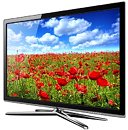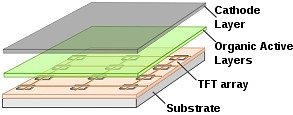qubit
Overclocked quantum bit
- Joined
- Dec 6, 2007
- Messages
- 17,865 (2.84/day)
- Location
- Quantum Well UK
| System Name | Quantumville™ |
|---|---|
| Processor | Intel Core i7-2700K @ 4GHz |
| Motherboard | Asus P8Z68-V PRO/GEN3 |
| Cooling | Noctua NH-D14 |
| Memory | 16GB (2 x 8GB Corsair Vengeance Black DDR3 PC3-12800 C9 1600MHz) |
| Video Card(s) | MSI RTX 2080 SUPER Gaming X Trio |
| Storage | Samsung 850 Pro 256GB | WD Black 4TB | WD Blue 6TB |
| Display(s) | ASUS ROG Strix XG27UQR (4K, 144Hz, G-SYNC compatible) | Asus MG28UQ (4K, 60Hz, FreeSync compatible) |
| Case | Cooler Master HAF 922 |
| Audio Device(s) | Creative Sound Blaster X-Fi Fatal1ty PCIe |
| Power Supply | Corsair AX1600i |
| Mouse | Microsoft Intellimouse Pro - Black Shadow |
| Keyboard | Yes |
| Software | Windows 10 Pro 64-bit |
The current display technology standard for most PCs and TVs is LCD nowadays. However, LCD technology has significant and well known drawbacks, such as limited viewing angles, poor colours, motion blur and input lag. These problems cause some people to swear by and hold on to the old and now obsolete CRT monitors, as it had none of these problems (it did however, have lots of others). There are various types of LCD technology in mainstream use today which attempt to address these shortcomings, but none fix them all. For example, TN displays are cheap to buy, relatively fast which reduces motion smear and input lag, but at the expense of viewing angle and colour accuracy, making them suitable for fast gaming and animation. Meanwhile, IPS displays have the opposite characteristics, making them suitable for professional photographic work, where accurate colours and vibrant pictures are essential.


However, AMOLED technology has the ability to fix all these problems in one go, leading to bright, crystal clear displays with wide viewing angles and excellent motion smoothness, which comes about because LEDs have extremely fast response times. But - there had to be a but - it is very expensive to produce, can be hard to view in direct sunlight and it's serviceable lifetime is relatively short, so it can't be commercialised easily for large displays such as TVs and monitors. Hence, to this date, AMOLED displays tend to be found in small gadgets, such as smartphones, where these issues are much less of a problem.
Now enter DuPont. They have wanted to bring AMOLED TVs to market for a good five years or so and they believe that they have cracked the problems. They have issued a press release stating that they are partnering with a "leading Asian manufacturer of Active Matrix Organic Light Emitting Diode (AMOLED) display products." but are mentioning no names just yet. Samsung would appear to be a leading candidate here and hopefully there will be products to show at CES 2012, given the timing of this announcement. If successful, AMOLED technology should quickly replace current LCD technology, with all its many compromises, in TVs and monitors.
There is precious little hard information about DuPont's improved manufacturing process right now, but they have produced a YouTube video here to give some idea of what's involved.
For general background information on AMOLED technology, Wikipedia has an article on it here. DuPont's website is here: www.dupont.com
DuPont's press release follows this article.
View at TechPowerUp Main Site


However, AMOLED technology has the ability to fix all these problems in one go, leading to bright, crystal clear displays with wide viewing angles and excellent motion smoothness, which comes about because LEDs have extremely fast response times. But - there had to be a but - it is very expensive to produce, can be hard to view in direct sunlight and it's serviceable lifetime is relatively short, so it can't be commercialised easily for large displays such as TVs and monitors. Hence, to this date, AMOLED displays tend to be found in small gadgets, such as smartphones, where these issues are much less of a problem.
Now enter DuPont. They have wanted to bring AMOLED TVs to market for a good five years or so and they believe that they have cracked the problems. They have issued a press release stating that they are partnering with a "leading Asian manufacturer of Active Matrix Organic Light Emitting Diode (AMOLED) display products." but are mentioning no names just yet. Samsung would appear to be a leading candidate here and hopefully there will be products to show at CES 2012, given the timing of this announcement. If successful, AMOLED technology should quickly replace current LCD technology, with all its many compromises, in TVs and monitors.
There is precious little hard information about DuPont's improved manufacturing process right now, but they have produced a YouTube video here to give some idea of what's involved.
For general background information on AMOLED technology, Wikipedia has an article on it here. DuPont's website is here: www.dupont.com
DuPont's press release follows this article.
View at TechPowerUp Main Site



 I got that statement from the article, so perhaps they weren't quite correct, lol.
I got that statement from the article, so perhaps they weren't quite correct, lol.